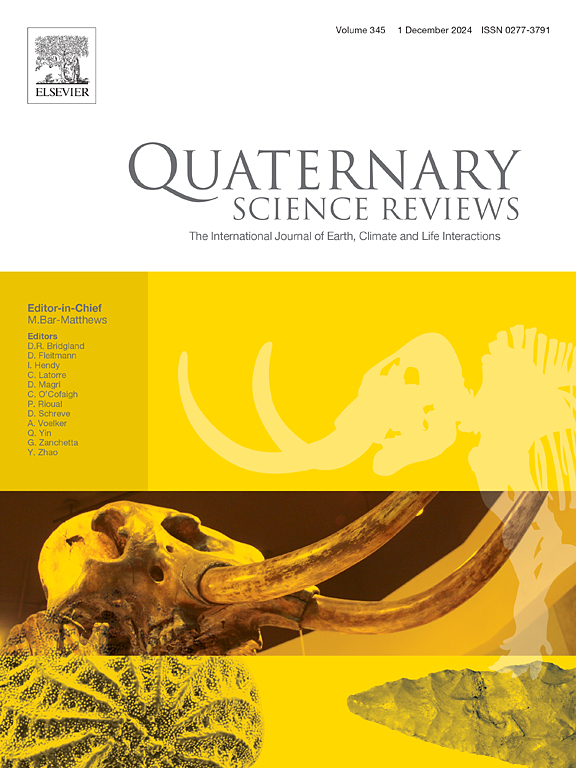A critical review of Late Pleistocene human-megafaunal interactions in Mexico
IF 3.2
1区 地球科学
Q1 GEOGRAPHY, PHYSICAL
引用次数: 0
Abstract
The timing and cause(s) of megafaunal (animals with body mass >44 kg) extinctions during the Late Pleistocene remain a topic of significant multidisciplinary interest. Determining the ecological and evolutionary history of megafaunal communities requires a detailed study of chronology, climate change, environment, and human impact. While some regions of North America are well-studied in this regard, others, such as Mexico, have been more neglected. This is despite the fact that, by the end of the Pleistocene, the region had witnessed the extinction of fourteen families (Chlamyphoridae, Megalonychidae, Mylodontidae, Felidae, Canidae, Ursidae, Tapiridae, Antilocapridae, Bovidae, Cervidae, Gomphotheriidae, Mammutidae, Toxodontidae, Macrauchenidae) and the regional extirpation of a further four (Equidae, Camelidae, Elephantidae and Megatheriidae). Moreover, this region is located at a biotic crossroads and has yielded some of the earliest dates for human occupation across the Americas. This makes Mexico an important study region to explore the effects of human presence and climate change on a variety of megafaunal species. However, research has been hindered by an uneven balance of research, preservation issues, lack of chronological control, and limited synthesis of the available data. In this paper, we provide a critical review of the available records of Late Pleistocene megafauna in Mexico and their relationship to human populations. We evaluate the quality of dates and stratigraphic contexts of recorded megafauna on a site-by-site basis while also exploring available information on human presence and impact on megafauna. We highlight that currently, the human impact on the decline of these populations is far from clear and that more multidisciplinary excavations of well-dated sites are needed. Nevertheless, we contend that current evidence suggests that human hunting of megafauna occurred across most of the Mexican territory in a variety of habitats, with some evidence in the south that these hunts were complemented by significant acquisition of small game, aquatic species and plant foods.
墨西哥晚更新世人类与巨型动物相互作用的评述
晚更新世巨型动物(体重44公斤的动物)灭绝的时间和原因仍然是一个重要的多学科兴趣课题。确定巨型动物群落的生态和进化历史需要对年代学、气候变化、环境和人类影响进行详细的研究。虽然北美的一些地区在这方面得到了充分的研究,但其他地区,如墨西哥,则受到更多的忽视。尽管如此,到更新世末期,该地区已经有14个科(衣蝗科、巨爪蝗科、Mylodontidae、Felidae、Canidae、Ursidae、Tapiridae、Antilocapridae、牛科、Cervidae、Gomphotheriidae、Mammutidae、Toxodontidae、macauchenidae)灭绝,另有4个科(Equidae、Camelidae、Elephantidae和Megatheriidae)在该地区灭绝。此外,该地区位于生物的十字路口,并产生了人类在美洲最早居住的一些日期。这使得墨西哥成为探索人类存在和气候变化对各种巨型动物物种影响的重要研究地区。然而,由于研究的不平衡、保存问题、缺乏时间控制和对现有数据的有限综合,研究一直受到阻碍。本文对墨西哥晚更新世巨型动物的现有记录及其与人类种群的关系进行了综述。我们在一个地点一个地点的基础上评估了巨型动物记录的日期和地层背景的质量,同时也探索了人类存在和对巨型动物影响的现有信息。我们强调,目前人类对这些种群减少的影响还远不清楚,需要对年代久远的遗址进行更多的多学科挖掘。然而,我们认为,目前的证据表明,人类对巨型动物的狩猎发生在墨西哥大部分地区的各种栖息地,在南部的一些证据表明,这些狩猎与大量获取小型猎物、水生物种和植物食物相辅相成。
本文章由计算机程序翻译,如有差异,请以英文原文为准。
求助全文
约1分钟内获得全文
求助全文
来源期刊

Quaternary Science Reviews
地学-地球科学综合
CiteScore
7.50
自引率
15.00%
发文量
388
审稿时长
3 months
期刊介绍:
Quaternary Science Reviews caters for all aspects of Quaternary science, and includes, for example, geology, geomorphology, geography, archaeology, soil science, palaeobotany, palaeontology, palaeoclimatology and the full range of applicable dating methods. The dividing line between what constitutes the review paper and one which contains new original data is not easy to establish, so QSR also publishes papers with new data especially if these perform a review function. All the Quaternary sciences are changing rapidly and subject to re-evaluation as the pace of discovery quickens; thus the diverse but comprehensive role of Quaternary Science Reviews keeps readers abreast of the wider issues relating to new developments in the field.
 求助内容:
求助内容: 应助结果提醒方式:
应助结果提醒方式:


